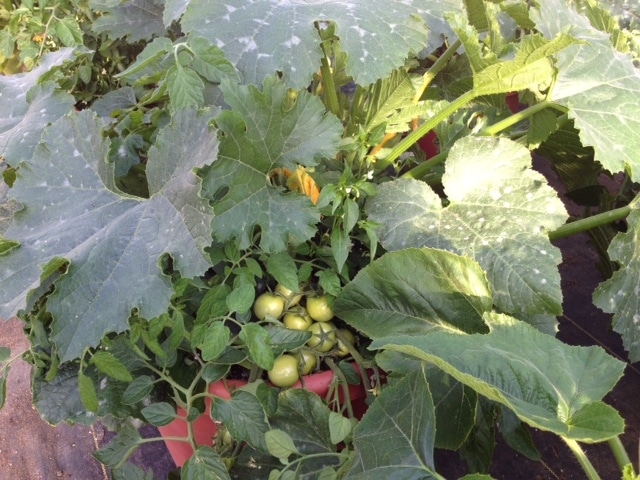A low maintenance vegetable garden
A vegetable garden isn’t a no-maintenance space, but with a little planning, soil care, good site selection, and smart crop choices it can certainly be a lower maintenance garden. If you’re new to gardening or just tight on time, keep it simple and keep it small. You can grow a lot of food in a single raised bed or a few containers. And thanks to hardworking plant breeders, we have so many compact vegetable varieties to choose from.
Your chosen site should offer plenty of sunshine – at least 8 hours per day. Most vegetables don’t appreciate having wet feet, so well-drained soil is also important. If your existing soil is less than ideal, a raised bed may be a good option. Raised beds offer so many advantages. They warm up early in spring, drain well, and can be intensively planted which means more food in less space. Plus, raised beds have far fewer weeds than in-ground garden. It also pays to pull weeds before they flower and set seeds.
The best soil for vegetables
Healthy soil is everything! These may be some of the easiest vegetables to grow, but they’re not going to be happy planted in poor soil. Blend in some compost before planting and again between successive crops to keep production high. Gardening in containers – use a high-quality potting mix– not garden soil – blended with compost for your potted vegetables.
Finally, if you’re still on the fence about building or making a new garden bed just for vegetables, consider that many of these crops – like bush beans, cherry tomatoes, and garlic – can be planted in existing flower gardens.
The easiest vegetables to grow
Leaf Lettuce
While most salad greens are fast to go from seed to harvest, leaf lettuce is fast and easy. Sow seeds directly in garden beds in mid-spring sprinkling them in a six-inch wide band. Keep the seed bed evenly moist until the plants are growing well. Or sow leaf lettuce in containers, window boxes. Baby greens are ready to pick when they’re two to four inches long. If you clip leaves from the outside of the plant, the center will continue to grow, prolonging the harvest.
Browse through the seed rack and you’ll discover dozens of awesome leaf lettuce varieties like Salad Bowl, and Black Seeded Simpson. Plant a small band of several colors and leaf textures for the prettiest salads.
Peas
There are a few different types of peas: snow peas, sugar snap, and shell peas and all are easy to grow. Sow pea seeds in early spring as soon as you can loosen and enrich the soil, about 4 to 6 weeks before the last expected frost. Sow seeds one to two-inches apart in double rows spaced six-inches apart. Peas can also be grown in containers and planters.
Garlic
Purchase bulbs to divide into cloves in early spring of fall. Tuck individual cloves in the garden in mid-autumn and do not harvest until the following year in early to mid-summer. Or plant cloves in the early spring and harvest late summer. The plants are bothered by few pests or diseases and grow fine in regular garden soil.
Once planted, mulch the beds to hold soil moisture and reduce weeds. Harvest when half of the leaves have yellowed, hanging the plants to cure in a dry spot for two weeks. After curing, clean and store bulbs. It really is one of the easiest vegetables to grow!
Bush Beans
Bush beans are almost foolproof! They go from seed to harvest in less than two months and offer weeks of tender pods. Beans appreciate warm soil and warm weather, so don’t rush spring planting. Plant seeds after the last frost, sowing them 2 inches apart in rows spaced 18 inches apart. Once the seedlings are growing well, thin bush beans to six-inches. Look for stringless varieties like Bush Blue Lake.
Cherry Tomatoes
Tomatoes are the number one garden vegetable grown in North America. Large-fruited varieties take a long time to deliver their harvest, but quick-growing cherry tomatoes start producing around two months from transplanting. Start with healthy seedings from the garden center, planting them in garden beds or large containers once the risk of spring frost has passed.
In the garden, stick to early maturing, productive cherry tomatoes like Sun Gold, Midnight Snack AAS, or Burpee Baby Boomer.
Summer Squash
It’s a garden fact: no matter how many summer squash plants you grow, you will always have more than you can eat – even if you only planted one! Transplant a starter plant or direct sow seeds in a bed well amended with compost after the last spring frost. Once fruits begin to form, harvest often for peak quality and flavor. For pattypan and round varieties, pick when the fruits are two to three inches in diameter. Harvest zucchini when they’re four to six inches long.
There are a lot of beautiful varieties to try in your garden. For zucchini try Spineless Perfection Green and Golden Zebra. New variety to try is Delicata. Another good variety is Early Summer crookneck .
Cucumbers
Cucumbers are warm season veggies. Transplant a starter plant or direct seed them in garden beds or containers a week after the last spring frost. Give them plenty of compost enriched soil and water consistently for the highest quality cucumbers.
If space is short, try growing compact bush cucumbers like Patio Snacker. If you have more space in the garden try varieties like Straight Eight or Marketmore. Gherking is your pickling variety. Try using small tomato cage to climb for space saving and easy harvest.

